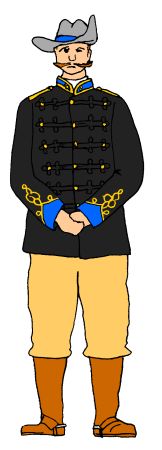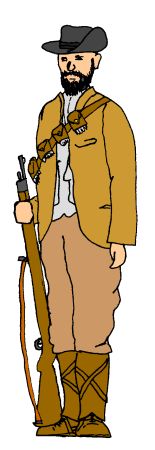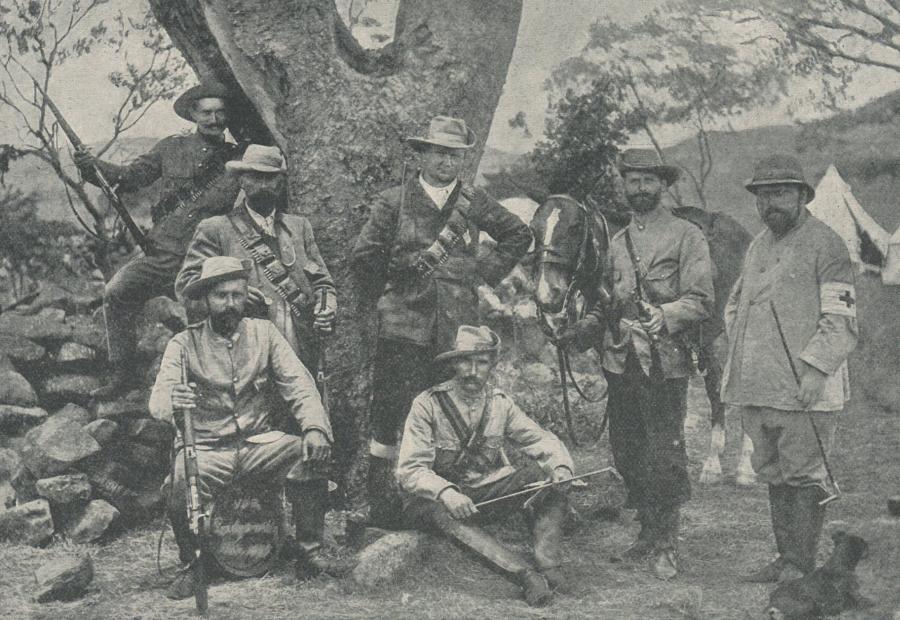Background to the
German Volunteers in the Second
Anglo-Boer War
In 1899, at the outbreak of the Second
Anglo-Boer War (commonly referred to simply as the 'Boer War'), the
modern South Africa was divided up into the British Cape Colony in the
south and two autonomous Boer states to the north, the Transvaal
(or South African) Republic and the smaller Orange Free State. The Boers were mostly
descended from Dutch migrants who had settled in South Africa from the
seventeenth century onwards but their communities also included more recent
European immigrants
especially after the discovery of gold in 1886. Among them was a sizable
German minority.German sympathies back home were firmly
on the side of the Boers but short of declaring war there was little
they could do assist the Boers. A British naval blockade meant that
volunteers (except for a German Red Cross Unit)
and weapons could not make their way to Africa. However, many German
arms were already in the Boer republics. Both the Transvaal and Orange
Free State artillery were equipped with Krupp guns among others, they
were also often trained and officered by Germans (for example Prussian Major
Richard Albrecht commanded the Orange Free State Artillery in the war) and many of the Boer fighters were
already armed with Mauser rifles previously purchased from Germany. When
war broke out many Germans already
living in the Boer Republics volunteered for active service.
Schiel's German Commando
A former Transvaal artillery
officer, Adolf Schiel was given permission
to raise a German volunteer Commando unit in Johannesburg in the
Transvaal Republic, numbering around 400 strong. The Johannesburg German Commando
took part in the invasion of Natal and were
effectively destroyed at the Battle of Elandslaagte on 20 October
1899. It was here that Graf Harra von Zeppelin was killed leading a
charge against the Gordon Highlanders. Schiel himself was wounded and
captured. He returned to Germany after the war and died from the after effects of his wounds received at
Elandslaagte a few years later. Some survivors of the unit continued to
serve in other German and Boer Commandos.
Krantz's German Commando
In Pretoria, the capital of the Transvaal Boer Republic another German
volunteer Commando unit around 400 strong was originally commanded by
Leutnant Hans Ulrich von Quitzow but later taken over by Leutnant Paul Krantz
who himself had previously disagreed with Schiel about the formation of
one larger German un it. This unit was also sent to
Natal and took part in the Siege of Ladysmith. After the fall of Pretoria, the
Commando was disbanded and their ranks split into other Commandos and
scouting units.
Von Quitzow's and Other German
Commandos
After his fall out with Krantz, Hans Ulrich von Quitzow formed a
new Commando of fifty German volunteers in the Orange Free
State. There were now several small Commando units of German
volunteers operating in the war. Arguments among command were a
common trait in the common splintering of them.
Austro-Hungarian Volunteer Unit
An Austro-Hungarian reconnaissance unit with 28 Austrians and nine
Hungarians was also formed by
Baron A von Goldeck to support the Boers.
Uniforms of the German Commandos
Uniformity was not one of the strong points of the Boer Commandos. Most
Boer soldiers wore civilian attire, slouch hats and bandoliers of
ammunition. The German volunteers were no exception. Some privately made
khaki tunics are seen but there were seemingly no regulations to their
uniforms and rank insignia was very rarely seen. Likewise no German national insignia seems to have been
worn. The only true uniforms seen among the German commandos are those
of the artillery units of the Boer republics.
Schiel's German Commando in Johannesburg
did however at least have their own flag, donated by the German
community of Johannesburg. It was a Transvaal four colour flag
(basically the horizontally striped red white and blue of the
Netherlands with a green bar down the left side) with the German national shield (black/white/red) in the
centre and the Republic's coat of arms surrounded by oak leaves upon it.
|



